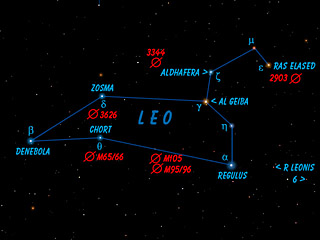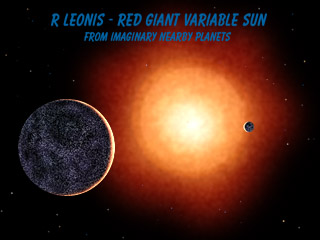
Stars in Leo


Stars in Leo |

|
|
Deep Sky Object Chart | M65/M66 | M95/M96/M105 | NGC2903 
|
Regulus (Alpha Leonis) The Lion's brightest star is the 21st brightest in the heavens, and is rated by astronomers as type B7V; type "B" stars are very hot, and Regulus shows this with a distinctly blue-white color (red stars are cooler, yellow medium). The temperature at the surface of Regulus is a toasty 13,000 degrees, compared to around 6,000 for our yellow sun. Regulus is a fairly nearby star, at 77.6 light years, and is far brighter than your average star, 197 times brighter than our sun. In the telescope, a 8th magnitude companion star makes Regulus a triple, not a double; large telescopes reveal that it is itself a very close pair. The name Regulus was later adapted from the more proper Greek "Rex" - Regal - or Cor Leonis, as the Romans called it - the Heart of the Lion.
|
|||||||||
|
Denebola (Beta Leonis)
The tail of the Lion is mightier than our sun, but is
outshone by Regulus considerably. At 36 light years,
Denebola is a relatively near star. Shining with a
white hot light 22 times brighter than the sun, this
beacon's name was originally "Dhanab al Asad", or 'tail
of the lion' in Arabic. The Chinese referred to this
star as the "Seat of the Five Emperors". Interestingly,
it is reported that astrologers thought that as it marks
the tail of the lion, Denebola brought bad luck, whereas
front-end star Regulus was a good sign. As we say here
in southern California: what-evuuurrrrr.
|
||||||||||

|
Al Gieba (Gamma Leonis) The gamma star of the lion is located just north of Regulus, and forms an interesting color contrast; the bluish color of the alpha star is very different from Al Gieba's yellow. This is a result of Al Gieba's cooler surface temperature (4401 degrees Kelvin, next to 13,000 for Regulus). But don't think Al Gieba is a slouch; it is twice as far away as Regulus (126 light years) and much brighter (1439 times as bright as our sun). In the telescope, Al Gieba can be split into a close and nearly equal pair - two yellow giant suns, slowly orbiting one another in a cycle that last many centuries. Each of the stars is perhaps seventy times the size of our sun. The name Al Gieba is apparently a mistake by later translators from the original Arabic, as it means "the forehead"; the name may have referred to another star, but the mistake has stuck, and the lion has a forehead in his chest.
|
|||||||||

|
R Leonis is a red giant sun, much brighter than our own and like many stars of this type, it is variable in its light output; in a period of 312 days, R Leonis swings from a faint naked eye star of magnitude 5 to a faint telescopic dot of magnitude 10: one hundred times fainter! R Leonis is one of the reddest stars known, and easy to locate, just 5 degrees west of Regulus.
|
|||||||||